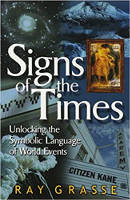
Image by 1tamara2
Narrated by Marie T. Russell.
The Age of Pisces: The Water Element (1 A.D. to 2100 A.D.)
Among the manifestations of the Piscean Age was the rise of a global religion centering primarily on symbols of water: baptism, walking on water, changing water into wine, and so forth. Indeed, for the student of astrological symbolism, Christianity offers a mother lode of correspondences in connection with Pisces. For example, Christian scripture speaks extensively of fishermen, wine, helping the downtrodden and outcasts of society, and the washing of feet -- all traditional symbols of Pisces. One of the defining miracles of Christ's ministry was the feeding of the multitude with two fishes and five loaves of bread. More subtly, the eating of fish on Friday by Catholics is linked by some to the fact that Friday is governed by Venus, the planet that is "exalted" (i.e., attains its optimal expression) in Pisces.
Were such correspondences intentional on the part of the Church fathers, or was their emergence purely synchronistic? Scholars disagree on this point, so we may never know for sure. But either way, we can study these symbols for what they reveal to us about the archetypal dynamics of the time. Viewed as a whole, they tell us that humanity was learning to relate to the divine and the world-at-large through a more emotional filter. In its more constructive aspect, this brought about a newfound element of compassion and faith in society, especially within Christian society. We see the emergence of a spiritual sensibility that spoke of "turning the other cheek" rather than the smiting of one's enemies. This was a shift from Roma to Amor, one might say.
In a more negative vein, this same emphasis on emotionality ushered in a spirit of dogmatism and persecution in the emerging religions. Pisces is intensely concerned with matters of faith. However, taken to extremes, this can lead to zealotry, self-righteousness, and the urge to establish absolute guidelines for all to follow. At its worst, the Piscean Age was an era of religious intolerance, when large populations were expected to show unquestioning allegiance to a monolithic belief system, as exhibited in much of Christianity and Islam during this time.
The Crucifixion: Symbol of The Piscean Era
One of the more striking Piscean symbols found in Christianity is its central image -- the crucifixion. It is sobering to consider that for nearly two thousand years now, Western culture has defined itself largely in terms of an image of a man nailed to a cross, tortured, and murdered in a most gruesome manner. Yet viewed archetypally, this singular seed-image contains the best and worst of the Piscean legacy. On a negative level, the crucifixion expresses dark Piscean qualities such as self-pity, masochism, guilt, and martyrdom. These reflect the self-dissolving principle of water, but directed in a more destructive, self-abnegating way.
In some respects, we might well call the Piscean Age the ultimate age of neurosis. For example, this was an era when many felt that suffering and guilt were somehow synonymous with spirituality. This is precisely the sort of delusion that arises when the ego is unhealthy or ungrounded, and thus finds itself sucked back into the more corrosive, ego-dissolving emotions of the soul.
Transcending the Ego
The crucifixion has a more positive interpretation, too. As esotericists know, Pisces symbolically relates to the transcendence of the ego and the surrendering of personal interests in service of a higher ideal. As the last sign in the zodiac (determined by the sun's counter-clockwise movement), Pisces is that final stage in the soul's evolution where the boundaries of personality have begun to dissolve and the soul merges with the cosmic ocean of existence. This is what the crucifixion means in its highest sense: the principle of sacrifice, worship, profound devotion. It is the water element at its most refined. A few examples of this higher aspect of Pisces are St. Francis of Assisi, or the ideals of chivalry and courtly love, with their ethos of self-sacrifice and idealism, that arose during the medieval era.
The Age of Aries brought an awakening of the outwardly directed ego, but the more feminine Piscean Age brought about a newfound sense of interiority or inwardness. In religious terms, this was most evident in the emerging Christian emphasis on moral reflectivity, or conscience, the flip side of which was the emergence of a new mood of guilt throughout Western society. Prior to Christianity, one rarely finds a sense of conscience or "sin" as we now think of it. By way of example, the earlier Greeks saw their relationship to the gods in more mechanical and external terms than we do now. When crimes were committed, one atoned for them not because of an inner sense of guilt so much as the belief that one had accrued a "stain" of sorts which could be removed through an appropriate sacrifice (Dickinson 1966).
Outwardly, this new sense of interiority was mirrored in the rise of architectural features like the dome and arch, so critical to the Islamic mosque and structures like the Pantheon in Rome. This interiority was visible as well as in the introduction of pupils into the eyes of Roman statues early in the Age; examine the ancient busts of early Romans and the Greeks and one finds that their eyes have no pupils. As symbols, artistic shifts like these signaled a new world of emotions opening up during the early Christian era, a development which would eventually make possible the later birth of modern psychology.
The Age of Aquarius: The Air Element (2100 A.D. to 4200 A.D.)
The most frequently asked question concerning the Aquarian Age is this: When does it begin? That is a bit like determining when the dawn starts. Is it when the morning sky first starts glowing, long before the actual sunrise? Or is it when the sun appears over the horizon? The same problem applies to understanding the timing of the Great Ages. An Age doesn't begin on a single day or year; it unfolds gradually over many centuries. Consequently, even if the Aquarian Age may not fully begin in earnest for several centuries yet (most estimates suggest somewhere between 2100 and 2800 A.D.), throughout this book we will consider many examples which suggest its symbols are already appearing in our world. The Internet and space travel are two instances we will be looking at in greater depth.
The deeper meaning of the Age can be understood by studying the underlying element involved. In the case of Aquarius, the influence of air is dominant. This is reflected in a literal way with the startling rise of aviation technologies over the last two centuries; humans are increasingly learning how to master the air realm, not only through aviation but in the construction of ever-taller buildings which allow us to live higher up off the ground. The media employs metaphors that reflect this elemental shift. A show is "on the air," or a broadcaster is "taking to the airwaves."
As with our other ages, such outer symbols are but reflections of an inner shift taking place throughout our culture, one that relates to an awakening of mind in the evolution of human consciousness. Understood symbolically, air is the medium through which we communicate our thoughts and ideas, and is the element most associated with rationality and thinking. What this means is that the Aquarian Age will undoubtedly witness major advances in humanity's intellectual growth, though admittedly at widely varying levels of sophistication. Terms like the "information superhighway" and the "information revolution" are two examples of how the impending Aquarian influence has already begun to propel our world toward more mental values and modes of experience. The modern separation of church and state is further evidence of the disengaging of our rational minds from the dogmatic and emotional concerns of the Piscean Age.
An essential key to understanding the meaning of Aquarius lies in [the fact] that each of the different elements repeats itself three times over during the course of the zodiac. Consequently, there are three earth signs, three water, three fire, and three air. In each expression of a different element, we see that elemental principle in subtly different ways. To illustrate this, let us focus here on the trio of air signs: Gemini, Libra, and Aquarius.
The Three Phases of the Air Element
Given the progressive nature of the zodiac, each of these signs reflects the workings of mind in broader and more impersonal ways. For instance, in Gemini, rationality expresses itself in its most personal form, through the workings of the everyday mind and ordinary forms of communication. In Libra, the rationality of the air element manifests in more interpersonal ways, with a mentality that is directed toward interactions with others in wider social contexts. An example of this is a teacher standing before a class, or a salesman dealing with clients.
In Aquarius, however, we see the element of air-rationality expressing itself through the most impersonal contexts possible, toward ever greater collectives, perhaps even the cosmos. For that reason, Aquarius might be described as the principle of cosmic rationality or cosmic mind, the ability to perceive or make connections of the most abstract and cosmic sort. Aquarius isn't simply concerned with ideas and theoretical relations; it is concerned with ideas and relationships that are global or universal in scope.
For this reason, the Aquarian Age will undoubtedly be concerned with knowledge of the broadest and most collective sort. A perfect example of this is modern science. Rather than focus its attention on a scientist's own ideas and feelings, science attempts to uncover those laws or principles which would apply everywhere, and everywhen. Already we see this impersonality expressing itself in the way many people are involved with social connections and networks extending over vast distances, as through the Internet or TV. Such technologies allow people across the world to communicate with one another, but in more cerebral ways.
This shifting orientation toward the Aquarian expression of air is no doubt behind the fascination we see with outer space and its exploration, as reflected in films like Star Wars or 2001: A Space Odyssey, and TV shows like Star Trek. Works like these capture the emerging spirit of "longing for the stars" that is so intrinsic to Aquarius.
Transitional Symbols on the Brink of Aquarius
With one foot in the Piscean Age behind us and another in the Aquarian Age before us, we find ourselves caught between radically contrasting, and sometimes conflicting, value systems. If the Great Ages represent a Shakespearean drama of cosmic proportions, then we have stepped onstage precisely at the point between acts, as it were, when the old props and back-drops have begun to be replaced by new ones. One result of living in this liminal in-between state is the rise of various transitional forms -- developments that are symbolic hybrids of the Piscean and Aquarian energies. Here are a few examples of these from recent times.
Televangelism: What happens when old-school Piscean-style Christianity meets up with Aquarian Age-style media technology? One result is the distinctly modern phenomenon called televangelism, in which preachers employ the fruits of global technology for spreading the gospel of salvation to even larger audiences than ever before.
The Abortion Debate: As one age comes up against another, there can be a violent clashing of values and ideologies from both sides of the divide. A vivid example of this is the modern controversy over abortion. On the one hand, there are the largely Christian-based "pro-life" advocates who represent the forces of the Piscean Age with their expression of sympathy for the helpless unborn.
On the other hand, we see the "pro-choice" advocates representing the forces of Aquarius, who champion the rights of individuals to decide their own fates. Over the years, there has been little compromise between the views of these two camps, and there is little hope for change in sight, but with good reason. They arise out of two fundamentally different paradigms, two radically different ways of seeing and evaluating the world -- as it were, one from the last Great Age and one from the next.
The Storming of the Bastille: Sometimes single events from history can serve as symbolic benchmarks in the transition between eras. One of the earliest and most dramatic examples of this was the storming of the Bastille on July 14, 1789, a pivotal event in the French Revolution. On this date, French radicals overtook and opened up the famed prison which had been holding political prisoners, and released those few who remained. In astrological symbolism, prisons are associated with Pisces, while the principles of freedom and revolution are associated with Aquarius. The opening up of a prison and release of its prisoners was a symbolic landmark in the move from the old authoritarian order to a more freedom-oriented one.
Addiction: Negative Symbol of Pisces
Alcoholics Anonymous: For astrologers, one of the more negative symbols long associated with Pisces has been the addiction to alcohol and other intoxicants. In the case of Alcoholics Anonymous, we see an example of people coming together specifically to break free from their addiction to alcohol, nicely symbolizing the effort to undo our bondage to Piscean-Age consciousness, through the support of a nondenominational group (typical of Aquarius). At the same time, AA still has one foot planted in the values of that receding Age as evidenced by its emphasis on the need to surrender to a higher power ("Let go and let God"), leading some to charge that this is in fact a modern secular religion with its own brand of commandments (the "twelve steps"). For better or worse, AA is a hybrid creation that blends the values of both Piscean and Aquarian Ages.
Transition Symbols in Cinema: The cinema is a rich source of symbolic clues for understanding the transition taking place in our society. The Truman Show: this ingenious film tells the story of Truman Burbank (played by Jim Carrey) and his attempts to break free of a media-permeated world in which he has spent his life as the unwitting subject. Lording over this world is a powerful artist named Christof (Ed Harris), who has choreographed the circumstances of Truman's life from birth onward as part of a vast performance piece known to all except Truman himself.
Throughout most of the movie, Truman is shown living in a world bounded by water (Pisces); each time he attempts to escape from this world, he is lured back with the promise of alcohol (a Piscean symbol). He eventually learns to overcome these temptations and succeeds in escaping from this water-bound world into an air-based one (Aquarius). The movie climaxes with the protagonist walking on water and literally stepping into the sky. Note the name of the God-like figure he is shown trying to break free of within that water-bound world: Christof, or, of Christ, another symbol of the Piscean era.
Transition to the Aquarian Age
Transitional Symbols in Literature: The transition to the Aquarian Age has expressed itself within the forms of modern literature as well. For instance, the passage from one age to another sometimes expresses itself in mythic symbols that depict a hero slaying (or rejecting) a creature symbolically associated with the prior age, such as Moses casting out the golden calf. In relatively modern times, a similar pattern can be found in books like Herman Melville's Moby Dick. Here we see a figure in the open air (Ahab) attempting to slay a creature of the sea, symbolizing transcendence over the water realm (Pisces). Additionally, if the whaling industry is taken as a symbol for modern industrial civilization generally, then Melville's tale under-scores the shift from a more emotional and intuitive age to the more technological and business-minded one of Aquarius.
Pilgrims' Immigration to America: Whether we know it or not, we are all pushed or pulled to some degree by the imperatives of our age. We act out the necessities of a broader drama. As a case in point, the attempt by pilgrims to escape religious persecution in the old world in order to find religious freedom in the new one expressed a shift from the more dogmatic and persecution-oriented Piscean era to the freedom-oriented Aquarian one. Little could they have realized how they were also setting the stage for a collective drama whose implications would extend far into the future and influence the geopolitical direction of an entire planet.
©2002.Reprinted with permission of the publisher,
Hampton Roads Publishing Company, Inc. www.hrpub.com
Article Source:
Signs of the Times: Unlocking the Symbolic Language of World Events
by Ray Grasse
 We may live in astonishing times, but they are not incomprehensible when you know how to read the signs. Ray Grasse deciphers the signs and correspondences of our nearing Aquarian future, using the tools of astrology, synchronicity, and mythology. He draws richly from contemporary religion, art, politics, science, even current movies, to show how the cultural signs of Aquarius and our likely future are already apparent and changing our world.
We may live in astonishing times, but they are not incomprehensible when you know how to read the signs. Ray Grasse deciphers the signs and correspondences of our nearing Aquarian future, using the tools of astrology, synchronicity, and mythology. He draws richly from contemporary religion, art, politics, science, even current movies, to show how the cultural signs of Aquarius and our likely future are already apparent and changing our world.
We are all participants in the global drama and all aspects of our inner and outer lives are bound up with the new Aquarian themes. ‘Signs of the Times' is the authoritative travel guide for the trip into our future – don't leave the present without it.
Info/Order this book. Also available as a Kindle edition.
About the Author
 Ray Grasse is a Chicago-based writer, musician and astrologer. He worked on the editorial staffs of Quest Books and Quest magazine for ten years, and has been associate editor for The Mountain Astrologer magazine since 1998. He received a degree in filmmaking from the Art Institute of Chicago in 1974 under experimental film pioneers Stan Brakhage and John Luther Schofill. From 1972 to 1986, he studied extensively with two teachers in the Kriya Yoga tradition, and in 1986 studied Zen meditation at Zen Mountain Monastery in New York. He has lectured internationally on the topics of astrology, synchronicity, meditation, and hypnosis, and maintains an active astrological practice with clients around the United States and abroad.
Ray Grasse is a Chicago-based writer, musician and astrologer. He worked on the editorial staffs of Quest Books and Quest magazine for ten years, and has been associate editor for The Mountain Astrologer magazine since 1998. He received a degree in filmmaking from the Art Institute of Chicago in 1974 under experimental film pioneers Stan Brakhage and John Luther Schofill. From 1972 to 1986, he studied extensively with two teachers in the Kriya Yoga tradition, and in 1986 studied Zen meditation at Zen Mountain Monastery in New York. He has lectured internationally on the topics of astrology, synchronicity, meditation, and hypnosis, and maintains an active astrological practice with clients around the United States and abroad.
Visit his website at RayGrasse.com

























